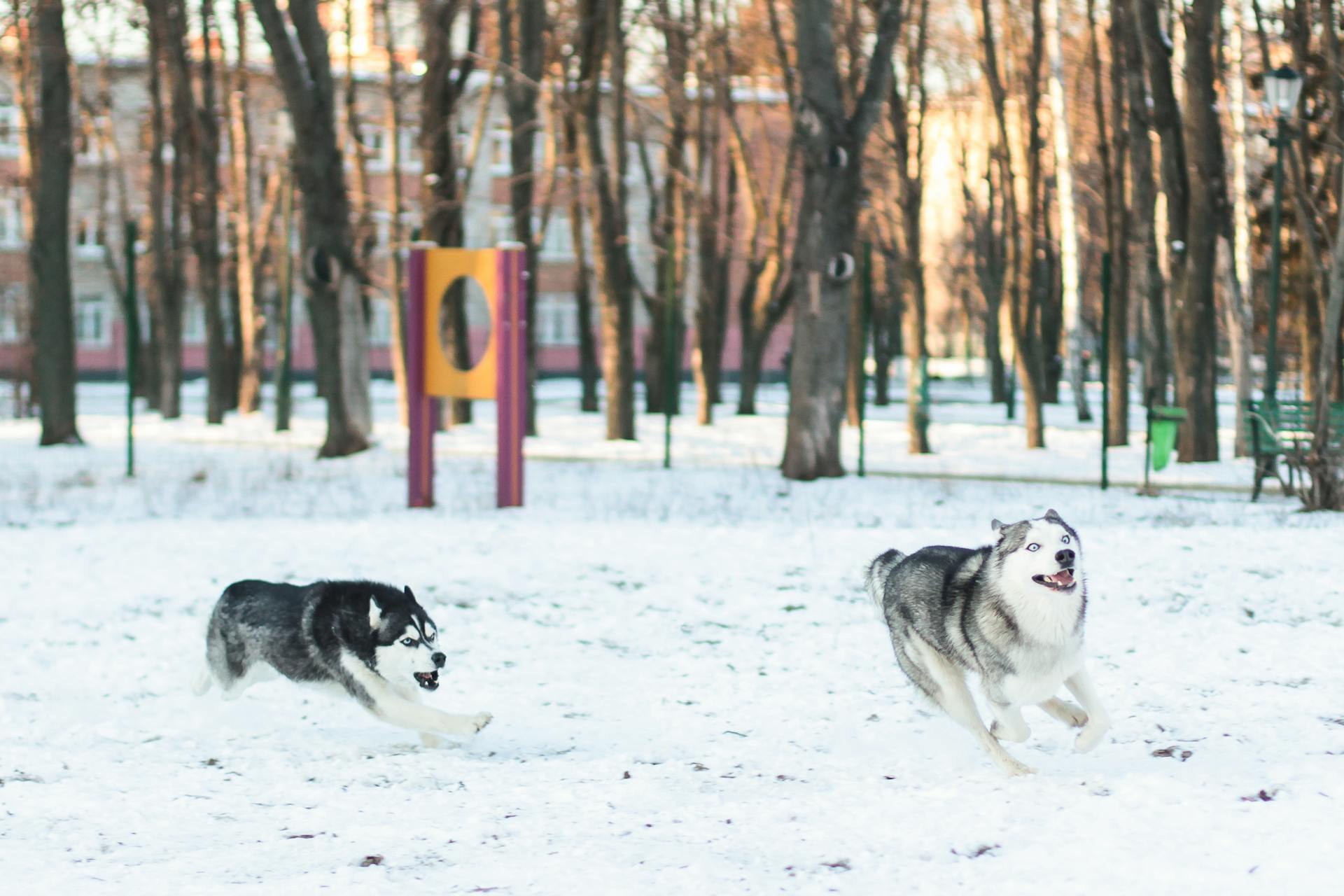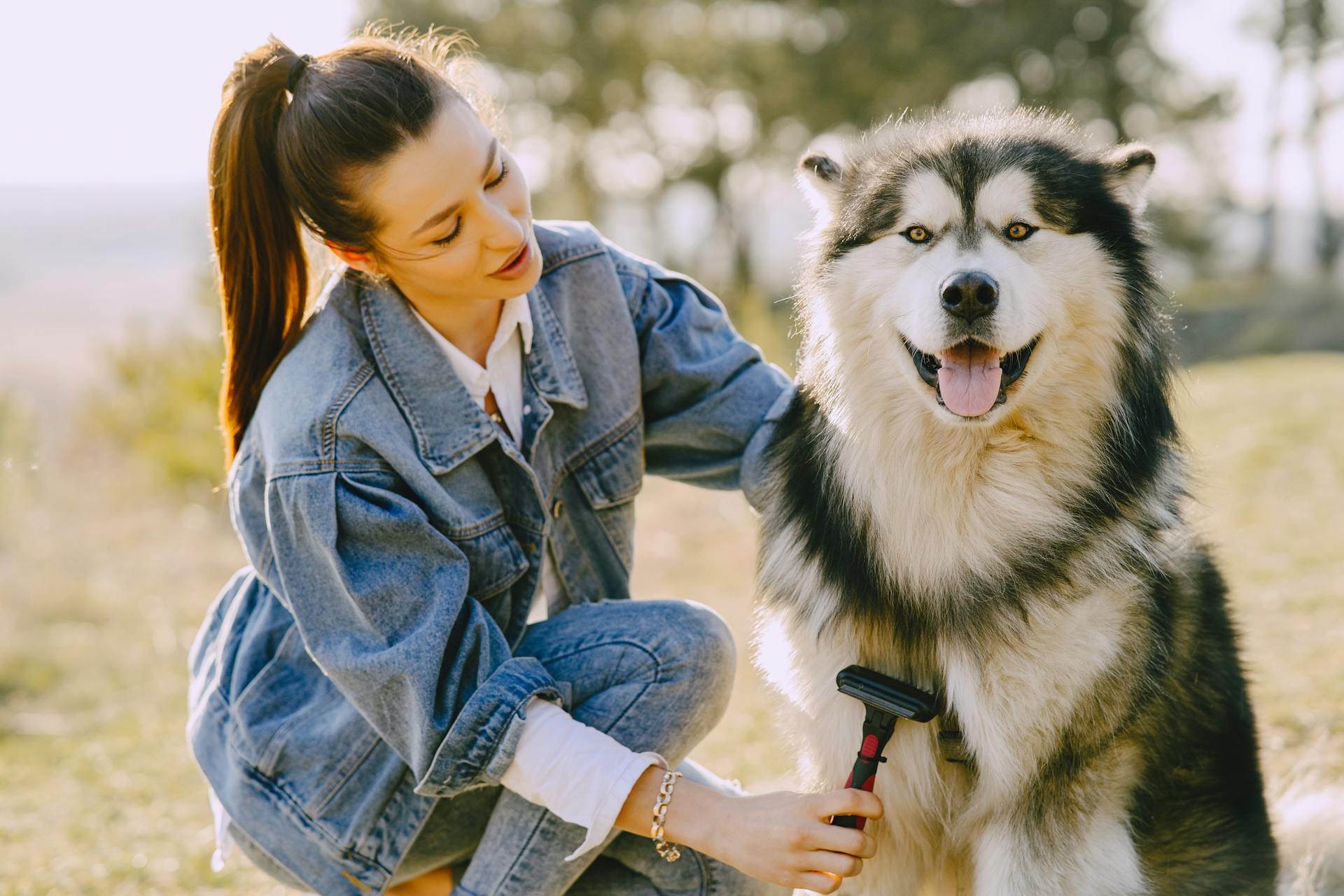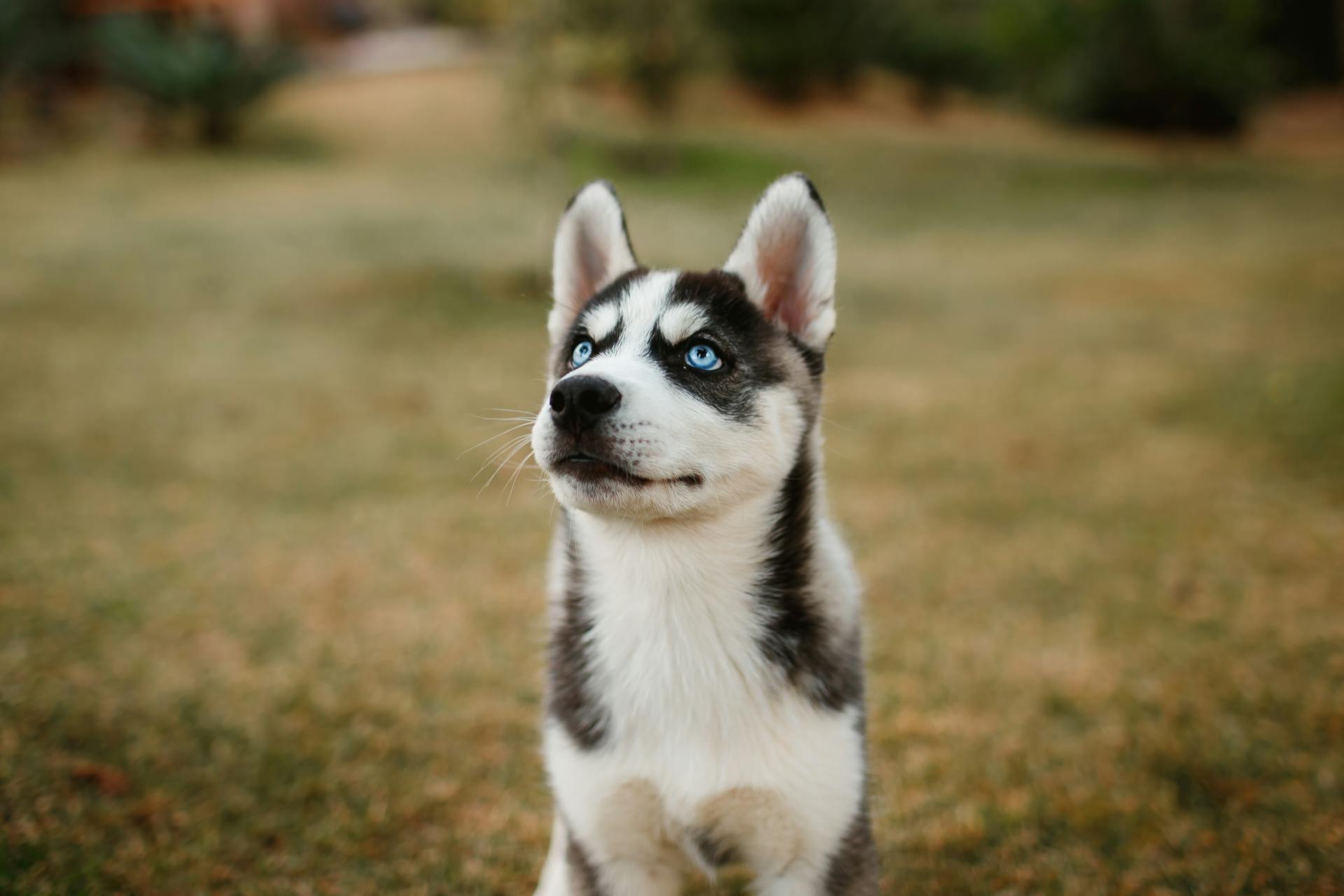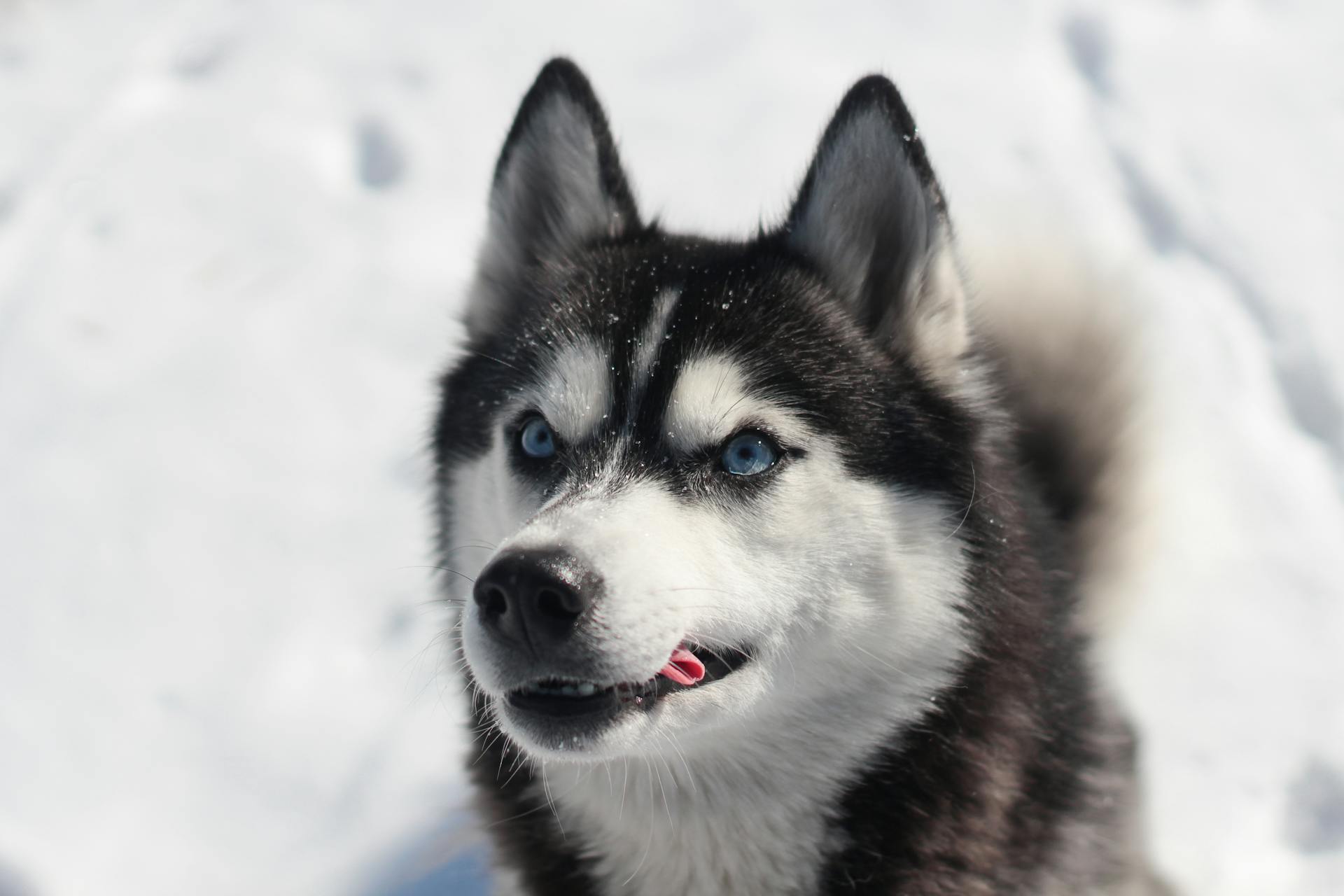
Siberian Huskies are a high-energy breed that requires regular exercise to stay happy and healthy. They need at least 30 minutes of physical activity per day.
Their thick double coat requires regular grooming to prevent matting and tangling. This includes brushing their fur several times a week.
Siberian Huskies are social animals that thrive on interaction with their human family. They are known to be pack animals and love to be around people.
They can be prone to separation anxiety if left alone for long periods of time. This can lead to destructive behavior such as chewing and digging.
Quick Facts
Siberian Huskies are a unique breed that originated in Siberia, Russia.
They come in a wide range of colors, including black, white, gray, red, and more combinations.
These dogs typically weigh between 35-60 pounds for females and 45-70 pounds for males.
Their lifespan is relatively short, ranging from 12-14 years.
Their thick double coat is designed for cold weather and requires regular brushing to manage shedding.
Siberian Huskies are known for their friendly and outgoing nature, making them great companions.
However, they can be stubborn at times and require early socialization and consistent training.
They thrive on exercise and love activities like running, hiking, and pulling sleds.
Their high energy levels mean they need plenty of physical and mental stimulation to stay happy and healthy.
Here are some key statistics about Siberian Huskies:
- Origin: Siberia, Russia
- Size: Females 35-60 pounds (16-27 kg), Males 45-70 pounds (20-32 kg)
- Lifespan: 12-14 years
- Exercise Needs: High energy levels, requires plenty of exercise
- Grooming: Heavy shedding coat, requires regular brushing
All-Around Friendliness
Siberian Huskies are renowned for their friendly and intelligent nature, making them wonderful companions who thrive on social interaction. They have an inherent need to be surrounded by both humans and fellow canines.
They express their sociable nature in unique ways, often "talking" to you using howls, growls, and whimpers, which is an endearing part of their personality.
Siberian Huskies lack the traits of a typical guard dog, which means they're not suited for protecting your home or family. This isn't a problem if you don't need a guard dog, but it's essential to consider their temperament when choosing a breed.
If left alone for long periods, Huskies may become stressed, bored, or destructive. Secure fencing is a must to prevent exploratory escapades, as they're notorious for their escape attempts.
Here are some key characteristics of Siberian Huskies:
- Welcoming strangers
- Strong-willed, which can make training challenging
- Good around kids and other dogs
- May chase cats and small animals due to high prey drive
Trainability and Behavior
Siberian Huskies are strong-willed, so early training is crucial for their development. This means starting their training during puppyhood to help them become a well-behaved family member.
They thrive on having a purpose, which is great for training. With consistent, structured training sessions and clear goals, you can establish a strong bond with your Husky.
A 6 ft fence is recommended for this breed as a pet, but some Huskies have been known to overcome fences as high as 8 ft. Electric pet fencing may not be effective, so you'll need to consider other options.
Siberian Huskies are pack dogs and need an owner who is the clear leader of the pack. This makes training easier because your dog will respect you.
They have a high energy level and need frequent exercise and companionship. Without proper care, they may be destructive, especially if left alone.
Siberian Huskies usually howl instead of barking, which can be frustrating for neighbors. They also tend to love everybody, making them poor watchdogs.
Early socialization is key to ensuring your Husky grows into a well-rounded dog. Enrolling them in a puppy kindergarten class and exposing them to many different people, sights, and sounds will help them develop good social skills.
Exercise and Environment
Siberian Huskies are high-energy dogs that need regular exercise to stay happy and healthy. They require about two hours of physical and mental stimulation daily.
A great way to exercise your Husky is to take them on long walks, but make sure to mix up the routes to keep things interesting for both you and your pup. Hiking is also an excellent option, as it allows your Husky to explore new environments and get some great exercise.
If you live in a hot climate, be sure to exercise your Husky during the cooler parts of the day to prevent overheating. And, as a bonus, keep an eye out for zoomies – those random bursts of energy are a normal and entertaining part of a Husky's behavior.
Your Husky's environment is also crucial for their well-being. They need a safe and enclosed space to roam, such as a fenced backyard. Avoid letting them off-leash unless you're in a securely contained area, as they can easily catch a scent or hear a noise and take off.
Here are some key considerations for your Husky's environment:
- Ample outdoor space is essential for your Husky's physical and mental health.
- A stable and tall fence is necessary to prevent escape attempts.
- Crate training can help when you need to leave the house for parts of the day.
- A bored Husky can lead to destructive behavior, so provide plenty of interaction and stimulation.
Exercise Needs
Exercise is crucial for Siberian Huskies, and they need about two hours of it daily.
Huskies are high-energy dogs with a primal desire to explore the world, so they need mental and physical stimulation to prevent boredom and escape attempts. You can engage their brain and body through activities like long walks and hikes.

Long walks are a great way to experience the world together, and changing up the routes keeps things interesting. Huskies are fast, so be sure to keep them on a leash unless you're in a safely contained area like a fenced backyard.
Hiking is another excellent way to explore new environments and get some exercise together. Competitive dog sports like agility, rally, or obedience competitions are also great options.
Huskies often get the zoomies – random bursts of energy to release pent-up energy, excitement, or stress. These are entirely normal and entertaining, and may be a sign that your pup needs an extra walk.
If you live in a hot climate, keep your activities to the cooler parts of the day, as Huskies were bred for cold climates.
Environment
Siberian Huskies are a breed that thrives in cooler temperatures, so if you live in a warm climate, be prepared to provide extra cooling measures for your furry friend.
They need ample outdoor space to run around and exercise, so if you're considering getting a Husky, make sure you have a spacious yard or access to a park.
Huskies are social animals that require tons of interaction with their owners and other dogs, so if you're away from home for parts of the day, consider crate training to give them a safe space to relax.
A bored Husky will look for things to do, and often that takes the form of "demolition duty", destroying your furniture or other things in the home while you're away.
If you're lucky enough to have a backyard for your Siberian Husky, it needs to be enclosed with a very tall, very stable fence to prevent escape artists like Huskies from roaming free.
On a similar theme: German Shorthaired Pointer Free to Good Home
Gait
The Siberian Husky's gait is truly a sight to behold - smooth and effortless, like they're gliding across the ground. This characteristic gait is a result of their quick and light feet.

Their trot should be moderately fast, with good reach in the forequarters and good drive in the hindquarters. This means they should be able to move with ease and balance.
When viewed from the front to rear while walking, the Siberian Husky's legs should not single-track. This means their legs should be moving in a way that creates a smooth, flowing motion.
As the speed increases, the legs will angle inward, with the pads falling on a line directly under the longitudinal center of the body. This is a natural movement for the breed.
The forelegs and hind legs should be carried straight forward, with neither elbows nor stifles turned in or out. This helps maintain balance and control.
Each hind leg should move in the path of the foreleg on the same side, creating a smooth and efficient gait.
Overview
Siberian Huskies were originally bred by the Chukchi people of Siberia to help them hunt and pull sleds.
They are known for their friendly and outgoing personalities, and they are also intelligent and easy to train.
Siberian Huskies are bred to pull sleds, so they need plenty of exercise. This means they require a lot of physical and mental stimulation to prevent boredom and destructive behavior.
If you're thinking about getting a Siberian Husky, do your research to ensure they are the right breed for you.
They are a high-energy breed that needs plenty of exercise, so they are not a good fit for everyone.
Here are some key characteristics to consider:
If you're willing to put in the time and effort, a Siberian Husky can be a wonderful companion. They are loyal, loving, and always up for an adventure.
Size and Appearance
Siberian Huskies are medium-sized dogs, standing between 19 and 24 inches tall at the withers.
Their weight varies between 35 and 60 pounds, with males typically being larger than females. Females weigh between 35 and 50 pounds, while males weigh between 45 and 60 pounds.
Their compact body is built for endurance, allowing them to pull sleds over long distances without tiring. They have a beautiful fluffy, thick double coat that comes in a variety of colors, including white, black, gray, and red.
Their ears are erect, triangular, and sit up high on their head. Their eyes are almond-shaped and can be blue or brown, with some Huskies having one eye of each color.
Their nose is straight, well-defined, and neither pointed nor square, and can be black, liver, or pink depending on their coat color. Their tail is thick with fur and resembles a fox tail, usually curving upwards when they're at attention.
Here are the average heights and weights for males and females:
Health and Care
Siberian Huskies are generally a healthy breed, but like all breeds, they can be prone to certain health conditions. They are one of the more commonly affected breeds for X-linked progressive retinal atrophy, a degenerative eye disorder that can cause blindness.
Huskies can also be prone to hip dysplasia, although it's relatively rare in this breed. In fact, the Orthopedic Foundation for Animals ranks the Siberian Husky 155th out of 160 breeds at risk for hip dysplasia, with only two percent of tested Huskies showing dysplasia.
To keep your Husky's eyes healthy, it's essential to have their eyes certified annually by a veterinary ophthalmologist. This can help detect conditions like cataracts, corneal dystrophy, and progressive retinal atrophy early on.
Huskies need regular exercise to stay happy and healthy. A daily walk of 30 to 60 minutes is recommended, and they should never be left off-leash when not in a fenced area. This is because they have a high prey drive and can easily get into trouble.
In addition to regular exercise, Huskies also need plenty of mental stimulation. This can be achieved through obedience training, playtime, and interactive toys. Failure to provide adequate mental stimulation can lead to boredom and destructive behavior.
Here are some common health issues that can affect Huskies:
- Cataracts: an opacity in the lens of the eye that causes difficulty seeing
- Corneal Dystrophy: an opacity in the cornea that can cause vision problems
- Progressive Retinal Atrophy: a degenerative eye disorder that can cause blindness
- Hip Dysplasia: a genetic deformity of the hip socket that can cause pain and mobility issues
- Von Willebrand Disease: a bleeding disorder caused by a deficiency in the protein needed for blood to clot
- Autoimmune Skin Disease: a skin disease that can cause hair loss and skin lesions
- Epilepsy: a seizure disorder that can cause recurring seizures
- Hypothyroidism: an endocrine disorder that can cause weight gain, hair loss, and lethargy
To keep your Husky healthy and happy, it's essential to provide regular veterinary care, including annual check-ups and vaccinations. You should also keep an eye out for any signs of illness or injury, and seek veterinary attention if you notice anything unusual.
Diet
Siberian Huskies don't need as much food as you might think, despite their high energy levels. They were bred to work hard on minimal food while performing demanding tasks like sled-pulling.
A recommended daily amount is 1.5 to 2 cups of high-quality dry food a day, divided into two meals. This is a relatively small amount of food for their size.
Dogs are individuals, just like people, and they don't all need the same amount of food. A highly active dog will need more than a couch potato dog.
The quality of dog food you buy also makes a difference - the better the dog food, the further it will go toward nourishing your dog, and the less of it you'll need to shake into your dog's bowl.
Too many treats can be a problem, so make sure you factor in those extra calories when planning mealtimes. It's crucial to keep your dog at an optimal weight, and even a couple of extra pounds can significantly affect their health.
Check this out: Shiba Inu $1
Grooming and Coat
Siberian Huskies have a double coat that's thicker than most other breeds, with a dense undercoat and a longer topcoat of guard hairs. This coat protects them from harsh Arctic winters and reflects heat in the summer.
Their thick coats require regular grooming to prevent matting and tangling. Brush them with a pin brush three to five times a week to minimize shedding.
Brushing their teeth daily is also crucial to prevent periodontal disease. Take them to the vet for a professional cleaning once a year.
Bathing them quarterly or every other month is recommended, unless they get dirty or live in warmer weather. Use a dog shampoo that suits their individual needs, such as a puppy shampoo for young dogs or a soothing shampoo for itchy skin.
Trim their nails about four times a year, as Husky nails don't grow fast. You'll know it's time when you hear a clickety-clack on hard surfaces.
Here's a quick guide to grooming your Siberian Husky:
Their thick coats can withstand temperatures as low as −50 to −60 °C (−58 to −76 °F). However, an excessively long coat can be a fault, as it lacks the thicker protection of the standard coat's guard hairs and becomes easily matted and encrusted with snow and ice.
Traditional Use
Originally, Siberian Huskies were used as sled dogs in the polar regions. Their fast pulling-style is a key characteristic that differentiates them from other dog types.
Huskies are bred for speed, and modern racing huskies, also known as Alaskan huskies, are an ever-changing crossbreed of the fastest dogs. This breeding has led to the development of sled-dog racing as a competitive sport.
Humans use huskies in sled-dog racing, and various companies have marketed tourist treks with dog sledges for adventure travelers in snow regions. These treks allow people to experience the thrill of dog sledding in a controlled environment.
Huskies are also kept as pets, and groups work to find new pet homes for retired racing and adventure-trekking dogs. Many owners now have huskies as pets in settings that are not ideal for sledding, leading to the need for alternative activities.
Children and Pets
Siberian Huskies can be very tolerant of children, but it's essential to supervise interactions between dogs and young children.
Huskies should be taught how to approach and touch dogs, and children should be taught not to approach dogs while they're eating or try to take their food away.
No dog should ever be left unsupervised with a child, as this can lead to biting or ear or tail pulling.
Socialization classes are crucial for Huskies to get used to other dogs and people, and they're also very affectionate to strangers.
Many Huskies maintain a strong prey drive towards small animals like squirrels, rabbits, and cats due to their harsh conditions in Siberia.
However, some Huskies thrive in multi-pet households, especially when they're raised with other pets from puppyhood.
Rescue Groups
If you're considering bringing a Siberian Husky into your family, you might be wondering where to start. There are many rescue groups dedicated to helping these beautiful dogs find forever homes.
You can find a number of reputable rescue groups listed online, but it's worth noting that many more exist. If you don't see a rescue listed for your area, contact the national breed club or a local breed club, and they can point you toward a Husky rescue.
Some notable rescue groups include the Delaware Valley Siberian Husky Rescue, MaPaw Siberian Husky Rescue & Referral Service, Inc., and the Siberian Husky Club of Greater Cleveland.
If you're open to adopting a mixed-breed Husky, you may also want to check local shelters for Siberian Husky mixes. These dogs can be less prone to health conditions that affect purebred Huskies.
Here are some rescue groups you can consider:
- Delaware Valley Siberian Husky Rescue
- MaPaw Siberian Husky Rescue & Referral Service, Inc.
- Seneca Siberian Husky Club
- Siberian Husky Club of Greater Cleveland
- Siberian Husky Rescue Site
Summary
The Siberian Husky is a breed that excels in endurance, giving the appearance of being capable of great endurance in both sexes.
Their ideal size is medium, with moderate bone and well-balanced proportions.
A Siberian Husky should have a proper coat, pleasing head and ears, correct tail, and good disposition.
They should never appear too heavy or coarse, like a freight-hauling animal, nor too light and fragile, like a sprint-racing animal.
In addition to specific breed faults, common structural issues are undesirable in the Siberian Husky, just like in any other breed.
Recommended read: German Shepherd Dogs 101 Animal Planet
Frequently Asked Questions
What is the difference between a Husky and a Siberian Husky?
There is no difference between a Husky and a Siberian Husky, as "Husky" is a general term often used to refer to Siberian Huskies. However, Alaskan Huskies are a distinct breed that shares similarities with Siberian Huskies but has some key differences.
What not to do to a Husky?
Avoid keeping Siberian Huskies in tight spaces, as they are skilled escape artists. If you live in an apartment, consider a different breed due to their high energy and space requirements.
Why are Siberian Huskies so expensive?
Siberian Husky prices vary due to factors like breeder reputation, location, and lineage, with puppies from high-quality bloodlines costing more. The price difference is largely driven by the dog's potential show quality and breeding potential.
What are Siberian huskies known for?
Siberian huskies are renowned for their exceptional sled-pulling abilities and versatility as working dogs. They're also beloved for their friendly, loyal, and affectionate nature.
Do siberian huskies bark a lot?
Siberian Huskies rarely bark, instead using various vocalizations to express emotions and needs. If you're considering bringing a Husky home, understanding their unique communication style is essential.
Featured Images: pexels.com


